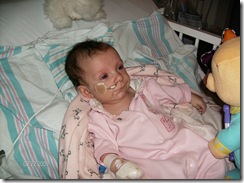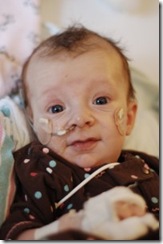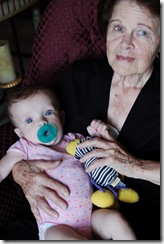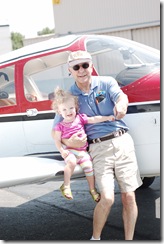This post might be a hard one to get out. Not because of the emotion of it, although that plays a part. But more because it brings up so many questions than answers. That’s always been kind of the nature of it with Kendall, though. More questions than answers.
We are often asked when we first knew something was “wrong” with Kendall (and people usually ask it with a sense of trepidation – like they hesitate to say that something is “wrong” with someone. but it’s ok, there’s something wrong with all of us – i am not personally offended if people word the question like this – because i’d rather have you ASK the question than make assumptions!). But the answer is that we knew from the second she was born. And if we are honest with ourselves, we knew it from a few weeks out from her birth, when i started having lots of problems with the pregnancy, things we just chalked up to my age, to back-to-back pregnancies, to my own chronic fatigue/fibromyalgia problems. Essentially what it seems like was happening was that as her energy needs were becoming more and more overwhelming, my body was failing to keep up with the production.
She was born “blue”, essentially not breathing very well at all. The midwife whisked her away  to begin administering oxygen and sternal rubs, and the NICU was called. You can read more about what happened at birth here. So from the start, she was having issues in many areas. Her list of “diagnoses” started growing in the NICU before we even brought her home. But we did eventually bring her home. The doctors kept telling us that “any day now she will wake up and she will know how to breathe and eat on her own then”. So we sat and slowly slowly slowly bumped that oxygen regulator down and we shoveled 15cc’s of formula into her with a bottle every four hours (and maybe ignored a little too much the fact that at least 10 of those cc’s were coming back up as puke right away) – but whatever – we just wanted her HOME with us! We wanted to believe what the doctors were saying, that she was just going to wake up and outgrow it and life would be back to NORMAL.
to begin administering oxygen and sternal rubs, and the NICU was called. You can read more about what happened at birth here. So from the start, she was having issues in many areas. Her list of “diagnoses” started growing in the NICU before we even brought her home. But we did eventually bring her home. The doctors kept telling us that “any day now she will wake up and she will know how to breathe and eat on her own then”. So we sat and slowly slowly slowly bumped that oxygen regulator down and we shoveled 15cc’s of formula into her with a bottle every four hours (and maybe ignored a little too much the fact that at least 10 of those cc’s were coming back up as puke right away) – but whatever – we just wanted her HOME with us! We wanted to believe what the doctors were saying, that she was just going to wake up and outgrow it and life would be back to NORMAL.
But it wasn’t normal.
We still had to take her for weekly weight checks, where we got a different doctor every time, telling us something different every time. At her 2 month checkup she got her first set of shots and this is when literally all hell broke loose. she started puking and pooping (at the same time) literally almost nonstop for the next ten days. She was pretty much not ever awake during this time, but again, we were told this was normal and fine and we were just still experiencing ‘NICU anxiety”. When this episode started was when i first began to have my suspicions that something more was really going on – as they had never been able to pinpoint her issues in the NICU beyond “transient tachypnea of newborn” – essentially she breathes too fast cause she doesn’t know any better. This did not explain her temperature dysregulation, her inability to gain weight (she actually lost a lot of weight in the NICU), her apparent infection with some unidentified bug (immune issues?), or the fact that she failed the newborn screening three times. We were not told any of this information at that time, only found out after we had left the hospital. They told us that her newborn screen fails were nothing to worry about, and i still to this day do not know WHAT or HOW she failed them. Three years later, its kind of a moot point. She’s been tested for basically everything under the sun that can be tested for, and we get the same results: Abnormal but not diagnostic. Meaning, she has a lot of characteristics of a lot of different metabolic diseases, but does not contain that particular gene defect in her chromosomes.
By 13 weeks old, 3 weeks after the psychotic vaccine issue, she had a wicked cold. She was rushed from the ped’s office  to the nearest hospital by ambulance, and that was when i knew this stuff was about to get REAL. She somehow survived that nite. I still to this day do not know how. My mom showed me a picture a few weeks ago of a blue skinned, glassy eyed, scrawny little baby, and my heart stopped as i realized that was MY baby, that nite, breathing what i can only imagine is something a step or two above “the death rattle”. If I ever doubted that God has something in store for this little girl – I look back at those pictures, and I think of that nite, and I know HE saved her, for some other purpose or reason. After narrowly surviving that nite, she was transferred to a regional childrens center an hour and a half from our home where she was fully worked up by a team of about 7 specialists in every specialty you can think of.
to the nearest hospital by ambulance, and that was when i knew this stuff was about to get REAL. She somehow survived that nite. I still to this day do not know how. My mom showed me a picture a few weeks ago of a blue skinned, glassy eyed, scrawny little baby, and my heart stopped as i realized that was MY baby, that nite, breathing what i can only imagine is something a step or two above “the death rattle”. If I ever doubted that God has something in store for this little girl – I look back at those pictures, and I think of that nite, and I know HE saved her, for some other purpose or reason. After narrowly surviving that nite, she was transferred to a regional childrens center an hour and a half from our home where she was fully worked up by a team of about 7 specialists in every specialty you can think of.
This is where we first heard the words “possible mitochondrial disease”. A neurologist at this hospital was quite concerned with the fact that Kendall was so extremely hypotonic (floppy), and that she had issues systemically. There was much talk of doing a muscle biopsy at that time (considered to be the gold standard for diagnosing many muscular and metabolic myopathies), but no one felt she was strong enough to survive such a procedure. She had gone in to the hospital with RSV, but ended up with bilateral pneumonia, which quickly turned into sepsis (systemic blood infection). She needed to have a PICC line placed for extra fluids and heavy duty medications, and even sending her to be sedated for that procedure was one fraught with anxiety and worry that she could not withstand the demands placed on her body.
But she did! And in spite of a few more hospitalizations throughout that horridly long spring, she finally began to do well with a specialized formula pumped into her stomach via a small tube we passed through her  nose and into her tummy (hopefully. sometimes we’d get it into her lungs and have to start the whole horrid process over again.) To say she was “doing well” is somewhat misleading in itself though too, because there were still many many nights when one or both of us would just lay awake with our hands on her chest, making sure she was still breathing. “Doing well” meant simply that she was not in the hospital being septic as we had seen her get in February, so we considered this an improvement.
nose and into her tummy (hopefully. sometimes we’d get it into her lungs and have to start the whole horrid process over again.) To say she was “doing well” is somewhat misleading in itself though too, because there were still many many nights when one or both of us would just lay awake with our hands on her chest, making sure she was still breathing. “Doing well” meant simply that she was not in the hospital being septic as we had seen her get in February, so we considered this an improvement.
She ended up getting a g-tube placed and a Nissen wrap performed to try to help force her stomach to work and absorb foods. When even these measures failed to “fix” many of her scary symptoms, we were referred to Childrens Hospital of WI in Milwaukee where they had a motility center to assess more of what was going on with her. From the first ten minutes we spent with our GI (gastrointestinal) doctor up there, we knew we were in the right place. The first few vials of bloodwork that he ordered began immediately to show issues with her metabolic system, and at our second appointment when we had JUST gotten some results back, he paged genetics from the room and told them to clear their schedule NOW and see this kid. Again we were schlepping back and forth from specialist to specialist, getting some pieces of the puzzle here, missing this or that symptom there, trying this that and the other thing in an effort to make her better. But after a few weeks, a lot more tests, and TONS more vials of blood sent to heck and gone, we finally got more confirmation that she had a presumed mitochondrial disease, etiology unknown, shortly after her first birthday.
 She was continuing to struggle with meeting milestones developmentally, and at 9 months after yet another immunization trial, she lost head control and many of the skills she had worked so hard to gain in the previous four months of intensive therapy.
She was continuing to struggle with meeting milestones developmentally, and at 9 months after yet another immunization trial, she lost head control and many of the skills she had worked so hard to gain in the previous four months of intensive therapy.
She also at this time had extremely high levels of a metabolic byproduct called “methylmalonic acid”, leading her geneticists to believe that she had a particular form of mito known as “SUCLA2”. We began to combat the acid levels that were building up in her system with daily injections of very potent vitamin B12 (read: the amount most adults would need in one month, we were giving to her every day, in her little teeny 9 lb body). Genetic testing came back negative for the known genes that cause SUCLA2, but she did have an “as yet unidentified” variant on one of the genes. Still though, this was not enough for our geneticist to say he had found her form of mito disease, and by then we were well into having more pressing issues to deal with than what we would call kendall’s disease!
She had her G-tube switched to a G-J (gastrojejunal) tube to feed her formula directly into her intestines when she was 14 months old, an idea which her team had suggested for about 5 months before I could finally wrap my mind around it. It just seemed like such a step backwards. But it was a huge help to Kendall that  was undeniable. She struggled with lots of illness that winter, at one point sleeping upwards of 21 hours a day, with a body temp that never rose above 94 degrees. Clearly things weren’t all rosy still! But we were still getting little to no direction as to WHAT was going on – just a lot of shoulder shrugs and "try to keep her warm!” I am sure if we were closer to her team, things may have been different on that end. But we’re a stubborn bunch around here, and we were bound and determined to just fix her with our love, so we didn’t run off to the doc every time she did something that scared us to death, and we just learned to try to help her deal as best as she could, as best as WE could.
was undeniable. She struggled with lots of illness that winter, at one point sleeping upwards of 21 hours a day, with a body temp that never rose above 94 degrees. Clearly things weren’t all rosy still! But we were still getting little to no direction as to WHAT was going on – just a lot of shoulder shrugs and "try to keep her warm!” I am sure if we were closer to her team, things may have been different on that end. But we’re a stubborn bunch around here, and we were bound and determined to just fix her with our love, so we didn’t run off to the doc every time she did something that scared us to death, and we just learned to try to help her deal as best as she could, as best as WE could.
So even though she had had the prerequisite “3 or more body systems involved in ways that do not otherwise seem to relate to each other” since birth, and even though we had LOTS and LOTS of bloodwork and even a muscle biopsy that all pointed towards a metabolic mitochondrial disease, and even though pretty much everyone on her medical team (roughly 12 docs, 5 therapists, a handful of nurses) assumed it was mito – we still felt like we needed to make sure no other stone was unturned, make sure we weren’t missing something that might be fixable. So in August of 2010, Kendall and I rode a series of little prop planes across the midwest to the Childrens Hospital of Pittsburgh, to meet with one of the few known “mito experts” in the country. Kendall was admitted for a week of intense testing, and at the end of the week, while we had a few other red herrings we COULD try to chase down, the consensus was that Kendall’s mitochondria were indeed dysfunctional, and were responsible for causing her multiple issues. And just in case I had any doubt about this diagnosis, or needed time “for it to sink in”, Kendall started having a massive metabolic breakdown literally within minutes of walking out of that hospital that week, and ended up sustaining damage to her GI tract that she still has not recovered from. Sure she got better, and eventually did come home from the hospital after that episode, and even managed to have a GREAT fall season last year. But shortly after her 2nd birthday, she got RSV AGAIN, and began a series of hospitalizations that ended finally this past June of 2011. {On Wednesday I will blogging more about what life looks like for Kendall these days, how she is affected currently, in case you are wondering about that!}
for causing her multiple issues. And just in case I had any doubt about this diagnosis, or needed time “for it to sink in”, Kendall started having a massive metabolic breakdown literally within minutes of walking out of that hospital that week, and ended up sustaining damage to her GI tract that she still has not recovered from. Sure she got better, and eventually did come home from the hospital after that episode, and even managed to have a GREAT fall season last year. But shortly after her 2nd birthday, she got RSV AGAIN, and began a series of hospitalizations that ended finally this past June of 2011. {On Wednesday I will blogging more about what life looks like for Kendall these days, how she is affected currently, in case you are wondering about that!}
to say that our road to a diagnosis has been anything but easy is quite an understatement.
in fact, i know of very few people for whom the diagnostic journey was “easy” or “straightforward” in any way. Getting news of a diagnosis of mitochondrial disease is always bittersweet – sweet in that there is finally, blessedly an answer or a REASON for all the issues that so many parents watch their children suffer through; bitter because this diagnosis brings with it no comfort.
Mitochondrial disease is currently without treatment, save for a wish and a prayer attempt at slowing down the progression of mitochondrial failure with a “cocktail” of vitamins and supplements aimed at helping the body complete the metabolic cycle of energy production. Since this cocktail is experimental at best, and contains “vitamins”, insurances do not cover it. The amount of these vitamins and supplements required to see any effect is so ginourmous that it is cost ineffective to purchase them for many families, especially considering that the only feasible way to consume the cocktail is to have it “compounded” – the hundreds of pills required on a daily basis are crushed into liquid form. $$$$!!! Not only is there no known treatment or cure for this disease, it is often fatal at a young age. This is a hard stat to type because it is the part of Kendall’s diagnosis that I do my hardest to ignore. 80% of the kids who are diagnosed in the first two years of life with mito do not live to see their tenth birthdays. It is my sincerest hope that this statistic somehow magically changes over the next 7 years, for the much improved. This year,though, an exciting announcement was made that some scientists have created a drug that is being proven to drastically reduce symptoms for some of the most affected mito patients, most notably those with severe neurologic implications. This is SO exciting! It is still in the testing phase, and is not available to “the general mitochondrial population” yet, but it is a glimmer of HOPE. It makes me so sad that this news comes too late for so many of the angels we have lost this year, and last, and the year before that…But as the mito logo says –  HOPE. ENERGY. LIFE. These are the things we hold on to.
HOPE. ENERGY. LIFE. These are the things we hold on to.
Mitochondrial disease is in itself an enigma. there is little rhyme or reason as to when or how it will strike. Some children have relatively mild symptoms right up to puberty, and then cannot survive the stress of the demands puberty puts on a body. Others are hit hard and heavy in the early years, but then seemingly find their stride and even have hope of making some slight improvements. Still others tend to stay stagnant in their symptoms, wherever on the spectrum they happen to fall. But one thing is certain – mito is unpredictable. It keeps you on your toes. The next fever your child gets could lead to major regressions and a lengthy hospitalization, or it could be just a blip on the screen. It is a state of constantly waiting for the other shoe to drop. That was a very hard adjustment for Ben and I as Kendall’s parents – not knowing when or how to react to some of her “issues”. And we still don’t “know” – but I think we’ve come to a kind of understanding with Kendall’s body, with her disease, however or whatever it will eventually be named. We will do our best to support her body in the areas it is weak, and her body will do its best to try to stay even keeled. We have no guarantees…
but does anybody really?
Our path to a diagnosis has not been an easy one. But we are not alone. On a long hard journey, having companions is always best. And above all – we are blessed. oh so very very blessed. Our daughters diagnosis makes us appreciate every sunset, every sunrise, every laugh, every crazy moment. We see life in a way differently than so many people get to experience – seeing the joy in the mundane, the smiles in the rain, the blessings in the midst of the storms. It’s kind of like getting a room on the 87th floor of a building with no elevator when you really would have preferred the 2nd or 3rd floor. It’s redonkulously hard some days, but if you just sit back and take a look at the view…oh its breathtaking. Gorgeous beyond description. Sit back and take it in.
I could ramble on this topic for another 37 pages. If you’ve made it this far, thanks.
To all of you on a similar journey – my heart is with you. It’s a journey no one wants to be on, but the rewards that come with the challenges – incomparable.
To our friends who have gone ahead of us and laid the path that we can pick out – thank you is not enough.
To those who walk beside us and with us on a day in and day out basis – keep on keepin’ on.
terra.

I don’t like that 80% statistic, either. You inspire me with your realness every day, Terra. You know you can count on me to pray at any hour!
I thank God for Twitter-fate. (I still don’t even like the word, Twitter…) I’m happy to know you from a distance because even from here, your light shines.
For me, I’m blessed to say that we’ve only dealt with fear for our son for a very brief time period. (23 days NICU, level 1 at birth) While my heart hurts for your grief and stress, I am also enlightened and inspired by your family’s perseverance. You not only endure, but you do it with grace. I love your family…
Shine on sister, shine on. And on Kendall’s worst days, and her best — know that God has fitted with you with exactly the right children for who you are.
I definitely feel more educated, but also like I know soooo very little about what life is really like for a child with “Kendall’s Disease”! Thank you for taking the time to write about it.
~d
Thank you for your story. We are still on the journey to a diagnosis (Alex is 7) and the doctors are just know talking Mito. It is scary and I am hoping it is ruled out but just want to know how to help him best. We are seeing a geneticist and neurologist but I am also taking him to see Dr. Frances Kendall in Atlanta as she is a specialist in Mito and other metabolic disorders. We hope to get some answers in a few weeks but am use to not getting any answers.
It is a long and tough journey to diagnosis usually – and full of scary info and uncertainties. But one thing is true for just about every mito kid i’ve ever had the pleasure of “knowing” – they are some of the toughest little cookies out there. I hope your travels can help you find peace with how to best help your son. And its not so much that you get used to not having “answers” – its more that you learn to change your definition of “answer”. At least that is how it went for me. I used to want hardcore solid info, black and white facts, exact timelines of expected “improvement”. And i’ve realize that the answer to all those things is “kendall”. Kendall will tell us all of those thing in her own way, and in her own time. But it took me a long time to really understand what that means. And i still don’t necessarily fully grasp it. But I have peace with it. For now. Best of luck to you and your son – I hope he is doing well at the moment!
I have mitochondrial disease, and I know firsthand what it’s like. You and your daughter truly are blessed. Like Kendall, I have had it since birth, and was originally misdiagnosed. I wish you and your family the best of luck in the days to come.
God bless you all.